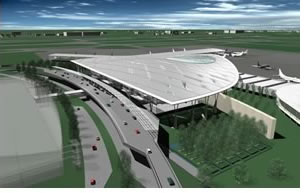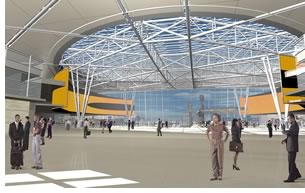

New Indianapolis Airport
Terminal Design Unveiled
HOK’s structure will be first new
U.S. terminal built since September 11, 2001
Indianapolis Mayor Bart Peterson, Airport Authority Board President Lacy M. Johnson, and representatives of HOK’s Aviation Group publicly unveiled the design for the new Indianapolis International Airport terminal building August 14. “This design represents the merging of economic opportunity, arts and culture, and the spirit of Indianapolis in a single magnificent structure,” Peterson says. “It is not only a culmination of more than 25 years of policy and planning, it represents the culmination of the economic growth of Indiana, a harbinger of future community success, and a continuation of Indiana’s historic position as “Crossroads of America.”
 Planning
for a new Indianapolis Airport began in 1975 when the Indianapolis Airport
Authority adopted a master plan for airport development. The plan left
room for a new “midfield terminal” complex between those runways
and new highway access from Interstate 70. Over the past 28 years, these
plans have been developed, reviewed, modified, and updated. The new midfield
airport terminal building will replace the existing Indianapolis International
Airport terminal, which opened in 1957 and has been renovated many times.
Planning
for a new Indianapolis Airport began in 1975 when the Indianapolis Airport
Authority adopted a master plan for airport development. The plan left
room for a new “midfield terminal” complex between those runways
and new highway access from Interstate 70. Over the past 28 years, these
plans have been developed, reviewed, modified, and updated. The new midfield
airport terminal building will replace the existing Indianapolis International
Airport terminal, which opened in 1957 and has been renovated many times.
Symbolic and secure gateway
As the gateway to Indianapolis and Indiana, the terminal building will
play a key role in defining the modern character of both city and state.
It is envisioned as a symbol of “both the long economic and cultural
history of central Indiana and of the bright future of Indianapolis and
the State of Indiana,” according to the architects.
The architects describe the terminal as a dynamic, changing form that reveals its purpose as destination, gateway, and powerful symbol of the city. Johnson concurs. “Every sector of the central Indiana community—government, business, labor, travel and tourism, arts and culture, and the traveling public—have a great stake in the success of the new Indianapolis Airport, and that success starts with this design,” she says. “From every perspective, this building is powerful, unique, and compelling.”
 The
new midfield terminal building has at its heart a civic plaza. Its circular
shape recalls the form of the city’s central public space, Monument
Circle. The plaza will of course provide both security and concessions,
and will incorporate artwork, provide public-event space, and enable visitors
to sample the character of Indianapolis and the region. The terminal roof
creates a symbolic threshold, emanating from the civic plaza. The form
is generated by joining a centralized arch with the rise and fall of the
building from check-in to departure. Encompassing high glass walls, the
building form rises over the plaza to reveal a view of the aircraft apron
and the city skyline.
The
new midfield terminal building has at its heart a civic plaza. Its circular
shape recalls the form of the city’s central public space, Monument
Circle. The plaza will of course provide both security and concessions,
and will incorporate artwork, provide public-event space, and enable visitors
to sample the character of Indianapolis and the region. The terminal roof
creates a symbolic threshold, emanating from the civic plaza. The form
is generated by joining a centralized arch with the rise and fall of the
building from check-in to departure. Encompassing high glass walls, the
building form rises over the plaza to reveal a view of the aircraft apron
and the city skyline.
The plaza is the heart of security for the new terminal. Security is focused in this single area, rather than at numerous checkpoints, as in most airports. In a nod to both security and ease of use, 96 ticket counters on one level will make surveillance easier. Upper decks will serve as observation platforms.
In addition to the terminal, the $974 million project includes a concourse, parking garage, site preparation, utility and road work, and airfield improvements. Overall, the project will provide enhanced terminal and airfield capacity, balance landside and airside capacity, reduce ground delay and taxiing times, increase margins of airfield safety, and improve terminal security.
A combination of federal grants, passenger facility charges, airline facility rents, and aircraft landing fees will pay for the airport, which is being built without state or local tax money. Construction of the new terminal is slated to begin in 2005, with a 2007 opening.
Copyright 2003 The American Institute of Architects.
All rights reserved. Home Page ![]()
![]()
 |
||
| Renderings courtesy of the architect.
|
||